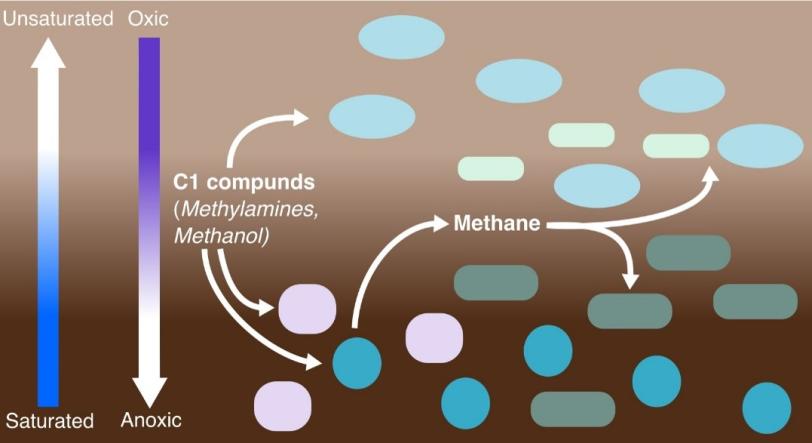Genomes of Single-Carbon Cycling Microorganisms in Floodplain Sediments
By Rasmussen, A.N.; Tolar, B.B.; Bargar, J.N.; Boye, K.; Francis, C.A.

The Science
In the present study, we generated over 1000 genomes for bacteria and archaea from 0.5 to 1.5 meters depth in montane floodplain sediments. This includes samples from above and below the water table that experience a range of oxygen availability. The genomes extracted from these samples revealed the presence of microbes that are capable of producing and consuming methane and other simple carbon compounds. We found microbes with genes for making methane at depths that lack oxygen and those that can consume methane at depths both with and without oxygen.
The Impact
The cycling of carbon by microorganisms in subsurface environments is of particular relevance in the face of global climate change. Riparian floodplain sediments contain high amounts of organic carbon that can be degraded into simple compounds such as methane or methanol—the fate of which depends on the microbial metabolic capabilities present as well as the water saturation and availability of oxygen. By studying the microbes present in sediments we can determine which pathways of carbon cycling may occur at different depths in the floodplain. This is important for improving the accuracy of carbon cycling and climate models.
Summary
We used high throughput sequencing of total microbial communities to understand single-carbon (C1) compound cycling – particularly methane-cycling – microorganisms in montane riparian floodplain sediments. We generated 1,233 metagenome-assembled genomes (MAGs) from 0.5 to 1.5 m depth below the ground surface capturing the transition between oxygen-containing, unsaturated sediments and oxygen-depleted, saturated sediments in the Slate River floodplain (Crested Butte, CO, USA). We recovered genomes of putative methane-producers, methane-consumers, and other C1 consumers (using compounds such as methanol and methylamines) (n = 57). Methane-producers were found only in oxygen-depleted depths and originated from three different groups, each with a different pathway for making methane. Putative methane-consuming microorganisms originated from within the Archaea (Ca. Methanoperedens) in oxygen-depleted depths and uncultured bacteria (Ca. Binatia) in depths with oxygen. The genetic potential for C1-consumption was widespread, with over 10% and 19% of MAGs encoding a methanol dehydrogenase or a substrate-specific methyltransferase, respectively. Overall, genomes from Slate River floodplain sediments reveal a potential for methane production and consumption in the system and a robust potential for C1-cycling.
Contacts
Anna N. Rasumussen
SLAC National Accelerator Laboratory
arasmuss@stanford.edu
Chris Francis
Stanford University
caf@stanford.edu
Funding
Funding for this work was provided by the U.S. Department of Energy Office of Biological and Environmental Research, Climate and Environmental Sciences Division, through its support of the SLAC Floodplain Hydro-Biogeochemistry Science Focus Areaunder contract no. DE- AC02-76SF00515
Publications
Rasmussen, A.N.; Tolar, B.B.; Bargar, J.N.; Boye, K.; Francis, C.A. (2024) Diverse and unconventional methanogens, methanotrophs, and methylotrophs in metagenome-assembled genomes from subsurface sediments of the Slate River floodplain, Crested Butte, CO, USA. mSystems, 9:e00314-24. https://doi.org/10.1128/msystems.00314-24
